Child soldiers in the American Civil War
Between 250,000 and 420,000 boys under 17 were involved in the American Civil War, for both the Union and the Confederacy.[1] It is estimated that 100,000 Union soldiers were under 15 years old.
Given the large number of young men in the American Civil War, compared to the number of older men, one author stated that it “might have been called The Boys’ War.”[2]
Reasons for joining
When the surrender of Fort Sumter was announced, men and boys of all ages on both sides of the conflict were eager to enlist. Abraham Lincoln initially only called for 90-day enlistments.[3] However, after the Union army was driven out of Richmond in the disastrous Peninsular campaign, and the Rebel Army began to march on to Washington, Lincoln issued a call for three hundred thousand three-year volunteers.[4]
Young boys had many of the same motives for joining the military as their adult counterparts did. In the North, young boys felt a desire to set the South straight.[1] In the South, young boys wanted to repel the North, whom they viewed as a hostile invader.[1]
A key difference between young boys’ and adults was their attitude towards slavery: in general, young boys on both sides had neutral feelings towards slavery.[1] Thus, few were motivated to fight for it or against it.[1]
By and large, the most popular reason young boys joined the military in order to escape what they viewed as a dull life on the farms.[5] Nearly all dreamed of coming home as heroes. Almost none imagined the conflict would drag on as long as it did.[1]
Methods of enlistment
Although the official minimum enlistment age was 18, there were various ways boys got around this.
First, the boys’ appearance often fooled recruiters. It is fairly common, especially for young teenage boys, to appear much older than they are. This trick was even easier during the chaos that often occurred at recruiting stations, when new units were hastily formed.[1]
Second, it was easy to lie about one’s age, especially given the fact that modern methods of identification (social security, driver’s license, computer databases) did not exist.[1] Further, recruiters were anxious to fill recruitment quotas. So, even though they were required to certify on the enlistment papers that they judged the volunteer to be of lawful age,[4] they often turned a blind eye to an underage recruit.[1] Such recruitment passivity increased as the manpower on both sides dwindled and both sides were desperate for more help.[5]
One trick was to have an underage recruit write "18" on his shoes and truthfully reply to the recruiter "I am over 18."
Third, some underage boys were able to enlist with the endorsement of an adult.[1] Ned Hutter, sixteen years old, joined the Confederate Army in Mississippi. His father vouched for Ned’s work ethic and shooting ability. The recruiter then accepted Ned into the unit.[1]
Despite such workarounds, many other boys joined the military legitimately by signing up for non-combat positions.[1] Many such youths signed up as musicians (such as drummer, bugler, flautist).[1] There were places for 40,000 such positions in the Union Armies alone.[2] They often performed other tasks, such as carrying canteens, bandages, and stretchers, to assist surgeons and nurses with the wounded; relaying orders on the battlefield; and at least a few picked up rifles and participated in the fighting.[5]
Conditions
Food
Perhaps the most common complaint of boy soldiers during the Civil War was the lack of food.[1] This is because the process for keeping an army fed relied heavily on the delicately perfect timing of many factors, including gathering, loading, and transporting food.[1] If any of these processes were delayed, or if any miscommunications occurred, it could be days or weeks before the army was fed.[1]
Hardtack was a staple food item, to the boys’ chagrin: "After we had been in the field a year or two the call, ‘Fall in for your hard-tack!’ was leisurely responded to by only about a dozen men.... Hard-tack was very hard. This I attributed to its great age, for there was a common belief among the boys that our hard-tack had been baked long before the beginning of the Christian era. This opinion was based upon the fact that the letters 'B.C.' were stamped on many, if not, indeed, all the cracker-boxes."[5]
Other staples included pork, coffee, and bread.[5]
Starving boys often devised intricate ways to sneak out of their camps and forage for food. They found food by either gathering it from the local land, or stealing it from local farmers.[1] In the Union Army, some soldiers initially objected to this practice as violating the Ten Commandments. But as the war wore on, it became evident that “such tender regard for Rebel property” strengthened the enemy and weakened the Union cause.[4] Consequently, “conscientious scruples stepped to the rear, and the soldier who had them at the end of the war was a curiosity indeed.”[4] Commanding officers forbade foraging, but often connived it and shared in the spoils.[4]
Clothing
Clothing was a crude procedure for both armies, especially towards the beginning of the war.[1] Once colors and patterns were agreed upon, uniforms were more easily standardized.[1] However, young boys often found themselves in uniforms that were too big.[1] Additionally, many boys continued to grow after being assigned a uniform, and many outgrew their uniforms.[1]
Some units did not have the resources to provide uniforms to young boys, so many had to wear their own clothes from home.[1]
As a result, many young boys often resorted to stealing uniforms from deceased soldiers, or bartered food and supplies in order to have their clothes tailored by locals.[1]
Marching
Excitement over enlistment swiftly gave way to the boring routines of camp life and marches.
"Day after day and night after night did we tramp along the rough and dusty roads ‘neath the most broiling sun with which the month of August ever afflicted a soldier; thro’ rivers and their rocky valleys, over mountains—on, on, scarcely stopping to gather the green corn from the fields to serve us for rations.... During these marches the men are sometimes unrecognizable on account of the thick coverings of dust which settle upon their hair, eye-brows and beard, filling likewise the mouth, nose, eyes, and ears."[5]
Death, injury, and capture
Young boys were not spared from the horrors of war that their adult counterparts faced, including violent deaths, injuries (and poor medical treatment), and appalling living conditions when captured.[1]
Young soldiers’ romantic illusions about military glory evaporated under the harsh realities of combat. They suffered hunger, fatigue, and discomfort, and gradually lost their innocence in combat. Every aspect of soldiering comes alive in their letters and diaries: the stench of spoiled meat, the deafening sound of cannons, the sight of maimed bodies, and the randomness and anonymity of death.[5]
The accounts of young Union prisoners at Confederate prison camps are especially harrowing. Sixteen-year-old Michael Dougherty was shocked by the sight of “different instruments of torture: stocks, thumb screws, barbed iron collars, shackles, ball and chain. Our prison keepers seemed to handle them with familiarity.” William Smith, a fifteen-year-old soldier in the 14th Illinois Infantry, was shaken by the physical appearance of prisoners at Andersonville in Georgia, a “great mass of gaunt, unnatural-looking beings, soot-begrimes, and clad in filthy trousers."[5]
Michael Dougherty was the only member of his company to survive imprisonment at Andersonville Prison in Georgia.[5]
"No one, except he was there in the prison can form anything like a correct idea of our appearance about this time. We had been in prison nearly five months and our clothing was worn out. A number were entire naked; some would have a ragged shirt and no pants; some had pants and no shirt; another would have shoes and a cap and nothing else. Their flesh was wasted away, leaving the chaffy, weather beaten skin drawn tight over the bones, the hip bones and shoulders standing out. Their faces and exposed parts of their bodies were covered with smoky black soot, from the dense smoke of pitch pine we had hovered over, and our long matted hair was stiff and black with the same substance, which water would have no effect on, and soap was not to be had. I would not attempt to describe the sick and dying, who could now be seen on every side."[5]
Offences and punishments
Young boys also committed the same offenses as their adult counterparts, and their commanding officers did not spare them from punishment.[4]
Offenses included:
- “Back talking” (i.e. addressing a superior with insolence) or refusal to follow military etiquette.
- Drunkenness.
- Absence from camp without leave.
- “Turbulence after taps” (i.e. causing a commotion after lights-out).
- Sitting while on guard
- Gambling
Punishments included:
- Hard labor.
- Carrying a log by oneself.
- Forcing the offender to stand on a barrel for an entire day.
- Confinement to the “guard-tent.” A veteran of the Civil War observed that this punishment “may not be though a very severe penalty; still, the men did not enjoy it, as it imposed quite a restriction on their freedom to be thus pent up and cut off from the rest of their associates.”
- Confinement in a box.
- Lashing the offender to a wheel.
- Wearing a board describing the offense.
- Being tied up by one’s thumbs.
- “Drumming out of camp” (usually for cowardice). This punishment involved stripping the offender of his equipments and uniform, and marching him through the camp with a guard on either side, four soldiers behind, and a fife and drum corps bringing up the rear. This gave the rest of the army the chance to publicly humiliate the offender.
- Death by firing squad (usually for desertion). Abraham Lincoln was so reluctant to approve the death penalty that he became famous (or, at least from the perspective of those in favor of the military's ultimate sanction, infamous) for his last-minute pardons and reprieves. Over time, Generals increasingly demanded executions be carried out before the President would have an opportunity to review it.[3]
Notable examples
Elisha Stockwell, Jr.[6] joined the Union Army at age fifteen. Since this was against his father’s wishes, he tricked his father by claiming that he was going to a Dutch dance. He told his sister he'd be back for dinner, but didn't return home for two years. He was in the Union Army for the entire duration of the war, participating in battles such as the Battle of Shiloh, the Siege of Vicksburg, and Sherman’s March to the Sea. He survived the war and wrote a memoir of his wartime experiences. His story is cited extensively in the awarding-winning children’s book, The Boys’ War.[1]
The most celebrated schoolboy performance of the war was the baptism of fire of the Virginia Military Institute Cadet Corps at the Battle of New Market. The corps was 215 strong when it reached the battle. The boys were eighteen or under (tradition has it that some were only fourteen).[2]
Washington and Lee University provided a company of sixty-four boys in the first days of the Civil War. Their average age was about seventeen, and their average weight was about 130 pounds. Of a total of sixty-five present in the two battles of Manassas, twenty-three were killed or wounded. In the forty battles in which it fought with the 4th Virginia Infantry, the company lost 100 dead or wounded, and forty-six captured, of a total strength of 150 from recruitments.[2]
Union
Mancil V. "Manny" Root. Root was the youngest soldier in the Union Army on record. He was born in Ohio in 1854 and enlisted as a drummer boy at the age of 11, serving in the 36th Wisconsin Infantry. He died in Cedar Rapids, Iowa in 1929.[7]
William Black. The Civil War’s youngest wounded soldier on record, he was twelve when his left hand and arm were shattered by an exploding shell.[1][5]
Avery Brown enlisted 1861 age 8 as a musician[8]
John Clem[9] joined the 22nd Michigan Volunteer Infantry Regiment as a drummer boy at 11 years of age, (Murphy) and became a mounted orderly on the staff of George Henry Thomas.[2] At the Battle of Chickamauga, he defiantly killed a Confederate colonel who ordered his surrender. For this, he was promoted to Sergeant. Clem went on to become a career soldier, retiring in 1915 with the rank of Brigadier General.[1]
George Penfield Bennett born 1852, enlisted in 1861 in New York, Company B, 1st Marine Regiment, at the age of 9 years and 7 days. Served on the ship his father commanded, the U.S.S. Cossack. He was a “powder monkey,” passing ammunition to the gunners from the magazine. During the battle of New Bern he was presented with a pony by General Reno for intrepidity on the battle field. [10]
Joseph B. Foraker born 1846 enlisted 1862 age 16
Paul Vandervoort born 1846 enlisted 1862 age 15
John S. Kountz born 1846 enlisted 1861 age 14
John Cook born 1847 served 1862 and 1863
Orion Howe born 1848 enlisted 1861 age 12
Charles E. King enlisted 1861 age 12 in Co F 49th PA Vols as a musician; died of wounds September 1862 Battle of Antietam [11]
Charles Smith enlisted 1861 age 14 in Co B 49th PA Vols as an musician;captured and paroled; discharged Sept 1864[12]
Frederick H. Dyer born 1849 Enlisted as a Drummer boy
John Whitnah Leedy born 1849 enlisted 1864
Benjamin Zellner born 1849 served Union army [PA][13]
Henry Foote Baker enlisted 1862 age 14[14]
Newton Peters enlisted 1861 age 15;
Samuel Scott enlisted 1862 age 16
Theodore Penland [1849-1950] enlisted age 16
Albert Woolson [1850-1956] enlisted 1864
James A. Clough born 1850 enlisted age 15
Aspinwall Fuller [born 1851] was a 13 year old Powder Monkey on the USS New Hampshire in 1864
Thomas Tad Lincoln [born 1853] was a commissioned Lt[15] in 1864
Galusha Pennypacker is reported to have enlisted in 1861 at age 16.
Arthur MacArthur Jr., from Wisconsin, failed to get into West Point in 1861, and instead wangled a place as adjutant of the 24th Wisconsin Volunteer Infantry Regiment at the age of seventeen, and was promoted to colonel (and nicknamed "The Boy Colonel") a year later. He commanded a regiment at the bloody battles of Resaca and Franklin, and was wounded three times. He went into the regular army, and retired in 1909 as the last lieutenant general of his era. He was the father of General Douglas MacArthur.
Henry Ware Lawton enlisted at age 18 in 1861 and was a brevet Colonel in 1865
Charles Cleveland Dodge at 20 was a Captain in 1861 and a General at 23 in 1863
Ranald Mackenzie garaduated from West Point at 22 in 1862 and a General at 25 in 1866
 Jimmy Dugan cavalry bugler
Jimmy Dugan cavalry bugler_-_Moulthrop%2C_photographer%2C_Phoenix_Building%2C_298_Chapel_St.%2C_N._Haven%2C_Ct_LCCN2016646132.jpg) Drummer Jimmy Doyle of Co. B, 18th U.S. Infantry Regiment
Drummer Jimmy Doyle of Co. B, 18th U.S. Infantry Regiment_of_Co._B%2C_8th_Michigan_Infantry_Regiment_in_uniform_with_drum_sticks_in_front_of_painted_backdrop)_-_Kertson_%26_Barker%2C_142_LCCN2017659639.jpg) Drummer Robert Henry Hendershot ("Drummer Boy of the Rappahannock") of Co. B, 8th Michigan Infantry Regiment
Drummer Robert Henry Hendershot ("Drummer Boy of the Rappahannock") of Co. B, 8th Michigan Infantry Regiment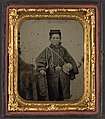 Johnny Jacobs drummer boy
Johnny Jacobs drummer boy.jpg) Arthur Gale Drummer boy
Arthur Gale Drummer boy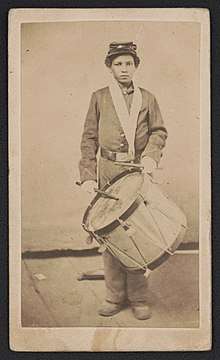 Taylor drummer boy of the 78th USCT
Taylor drummer boy of the 78th USCT_(14576309347).jpg) George T. Ulmer
George T. Ulmer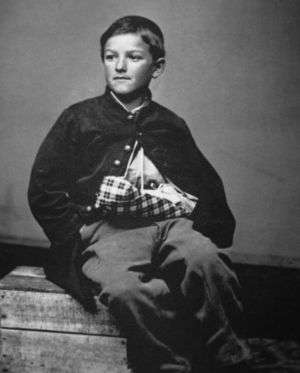 William Black, drummer boy for the Union
William Black, drummer boy for the Union John Clem
John Clem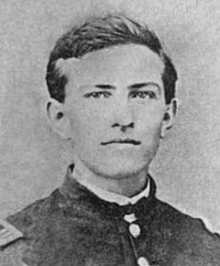 Joseph Foraker as a captain in the Union Army
Joseph Foraker as a captain in the Union Army
 John S Kountz
John S Kountz.jpg) John Cook [Bugler]
John Cook [Bugler] Orion Howe
Orion Howe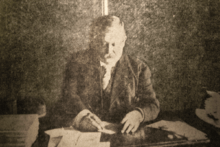 Frederick H Dyer
Frederick H Dyer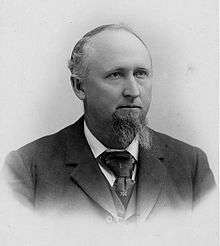 John Whitnah Leedy
John Whitnah Leedy Newton Peters and Samuel Scott in above photograph [Band leader Patrick Yard served 1861-1865
Newton Peters and Samuel Scott in above photograph [Band leader Patrick Yard served 1861-1865 Drummer boys off duty, playing cards in camp, winter of 1862
Drummer boys off duty, playing cards in camp, winter of 1862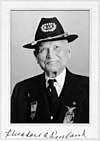 Theodore Penland
Theodore Penland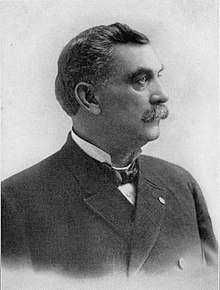
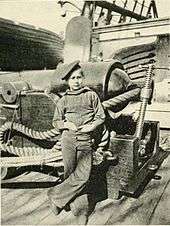 Aspinwall Fuller a powder monkey on the USS Hampshire, circa. 1864
Aspinwall Fuller a powder monkey on the USS Hampshire, circa. 1864 Lt Thomas Lincoln 1864
Lt Thomas Lincoln 1864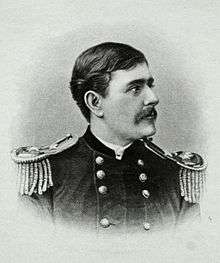 Galusha Pennypacker
Galusha Pennypacker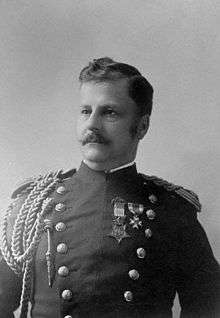 Arthur MacArthur Jr
Arthur MacArthur Jr.jpg) Henry Ware Lawton 1862
Henry Ware Lawton 1862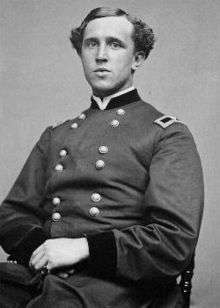 General Charles Cleveland Dodge
General Charles Cleveland Dodge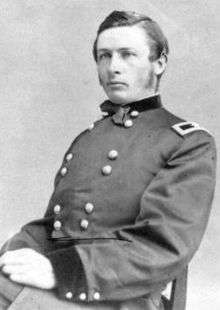 General Ranald Mackenzie
General Ranald Mackenzie
Confederacy
Glenn Reynolds (sheriff) born 1853 served in Civil War [Texas] against Indians
Charles F Mosby enlisted 1861 age 13
James P. Collier age 14 "killed June 1862 at Battle of Seven Pines as substitute for his brother Tip."[16]
James Morris Morgan was enlisted as a Midshipman 1861 at 15[17]
Henry Andrew Heck Thomas age 12 served 1862-1863
Dallas Stoudenmire is reported to have enlisted at age 15
Edwin Francis Jemison enlisted in 1861 at age 16; he was killed in 1862 at the Battle of Malvern Hill
Isidor Strauss {b.1845} In 1861 he was elected an officer in a Georgia Military unit [18]
John A Wyeth enlisted 1861 age 16
Sgt William T. Biedler 16 years old, of Company C, Mosby's Virginia Cavalry Regiment with flintlock musket
Allan C. Redwood [b.1844] served 55th Virginia Infantry
Walter Mackenzie Clark born 1846 in 1861 age 14 was Lt 22nd N.C; 1862 Adjutant 35th N.C.; 1864 Major 6th N.C. Battalion; 1865 Lt. Col. 70th N.C. age 17
Jesse James went to war at age 16 in 1863
Sumner Archibald Cunningham Born 1843 served 1861-1864
Francis Marion Gibson[1847-1939] enlisted at age 15 and served 2 years and several months
John F Brown enlisted 1861 age 17 Co G Lamar Rifles 11th Mississippi Rifles
Marcellus Jerome Clarke Enlisted at age 17 in 1861
Henry Howe Cook promoted to Lt age 17 in 1861
Texas Jack Omohundro Born 1846 went to war age 17
Henry King Burgwyn was a Lt Col age 19 in 1861
John Herbert Kelly became a general age 23 in 1863
William Paul Roberts became a general age 23 in 1864
John C. C. Sanders became a general age 24 in 1864.
 Drummer A.K. Clark [center with drum] "Clinch Rifles" Georgia May 1861
Drummer A.K. Clark [center with drum] "Clinch Rifles" Georgia May 1861 Drummer Charles F Mosby
Drummer Charles F Mosby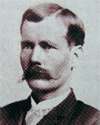
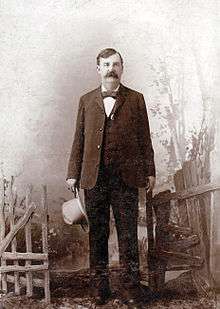 Henry Andrew "Heck" Thomas
Henry Andrew "Heck" Thomas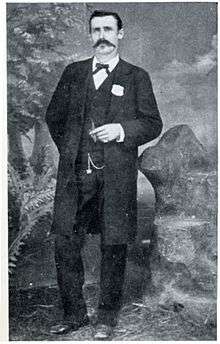 Dallas Stoudenmire
Dallas Stoudenmire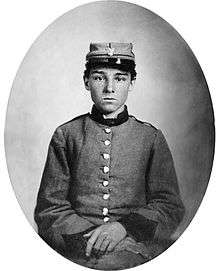 Edwin Francis Jemison
Edwin Francis Jemison_Straus_marriage.jpg) Isidor Straus & wife
Isidor Straus & wife John A Wyeth [upper right hand corner];Allan C Redwood [far right middle row]; Sumner Archibald Cunningham is 2nd from right bottom row
John A Wyeth [upper right hand corner];Allan C Redwood [far right middle row]; Sumner Archibald Cunningham is 2nd from right bottom row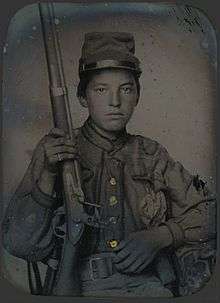 Sgt William T. Biedler
Sgt William T. Biedler Walter Mackenzie Clark
Walter Mackenzie Clark._Missouri_bushwhacker_riding_with_Bloody_Bill_Anderson.jpg) Jesse James 1863
Jesse James 1863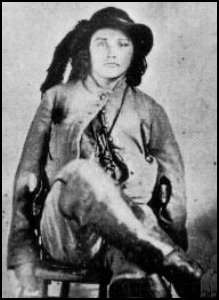 Marcellus Jerome Clarke
Marcellus Jerome Clarke Henry Howe Cook
Henry Howe Cook Texas Jack Omohundro
Texas Jack Omohundro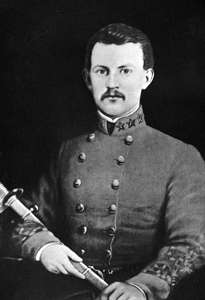 Henry King Burgwyn
Henry King Burgwyn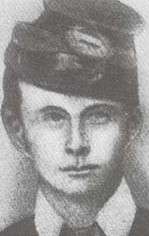 John Herbert Kelly
John Herbert Kelly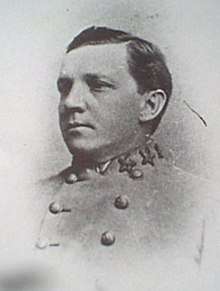 William Paul Roberts
William Paul Roberts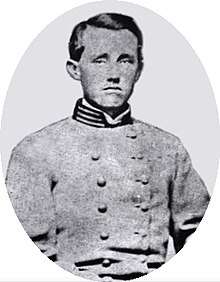 John Caldwell Calhoun Sanders
John Caldwell Calhoun Sanders Unknown Confederate soldier estimated at being 14 years of age killed at Petersburg Virginia April 2, 1865
Unknown Confederate soldier estimated at being 14 years of age killed at Petersburg Virginia April 2, 1865
Statistics
Federal Soldiers:
- 2,000,000+ were 21 or younger
- 1,000,000 were 18 or younger
- 200,000 were sixteen or under
- 100,000 were fifteen or under
- 300 were 13 or under—most of these were fifers or drummers, but regularly enrolled, and sometimes fighters. Twenty-five were ten or under.[2]
These numbers are staggering compared to the number of older men:
- 46,000 were 25 or older
- 16,000 up to the age of 44
References
- Murphy, Jim (1990). The boys' war : Confederate and Union soldiers talk about the Civil War. New York: Clarion Books. ISBN 0395664128.
- Houhlihan, Burke Davis. Drawings by Raymond (1982). The civil war: strange & fascinating facts (1st ed.). New York, NY: Fairfax Press. ISBN 0-517-371510.
- Freedman, Russell (1987). Lincoln : a photobiography. New York, N.Y.: Clarion Books. ISBN 0-89919-380-3.
- Reed, John D. Billings ; illustrated by Charles W. (1981). Hardtack and coffee, or, The unwritten story of Army life. [Alexandria, Va.]: Time-Life Bks. ISBN 0-8094-4210-8.
- "Children and the Civil War".
- Abernethy, Byron R., ed. (1985). Private Elisha Stockwell, Jr., sees the Civil War. Norman: University of Oklahoma Press. ISBN 0806119217.
- Mancil Root
- Avery Brown
- Patterson, Michael Robert. "John Lincoln Clem, Major General, United States Army". www.arlingtoncemetery.net.
- Newspaper, The Rock Island Argus (Rock Island, Illinois), 02 Feb 1905, Thu, Page 2. From Newspapers.com.
- History of the 49th PA Vols p.23; pp/124-125
- History of the 49th PA Vols p.23; pp.124-125
- Find a Grave memorial
- SUVCW Photos from the Past
- Documents of the Assembly of the State of New York 1909
- Engraving on side of headstone at Maplewood Cemetery, Charlottesville, Va. His brother Tip Collier is memorialized on the front of the same headstone, having died at age 33 in 1877. Tip would have been 18 in 1862 when his brother James went to war in his stead.
- revollections of a Rebel....James Morris Morgan
- but was not allowed to serve because of his youth; in 1863 he went to England to secure ships for blockade running.Jewish Encyclopedia Isidor Straus; for details of his brief service see Kurt Stone's "The Jews of Capital Hill.."(p.54)